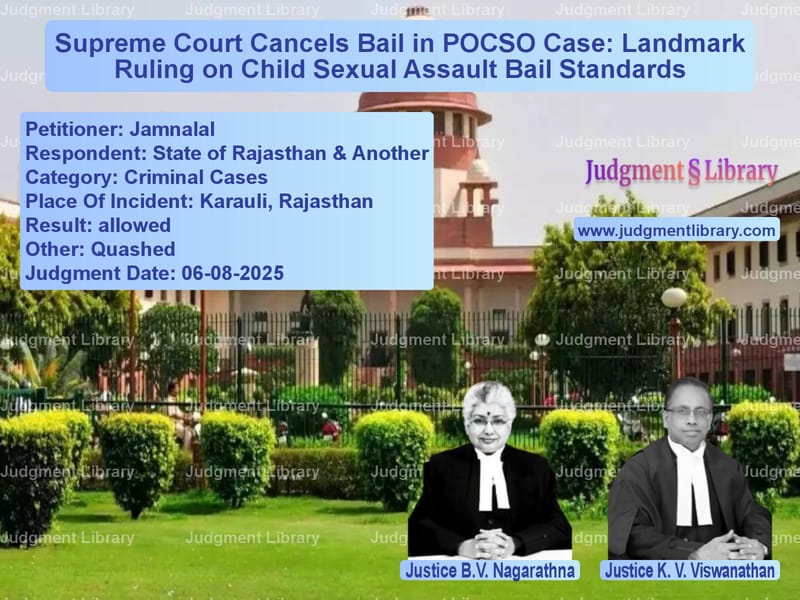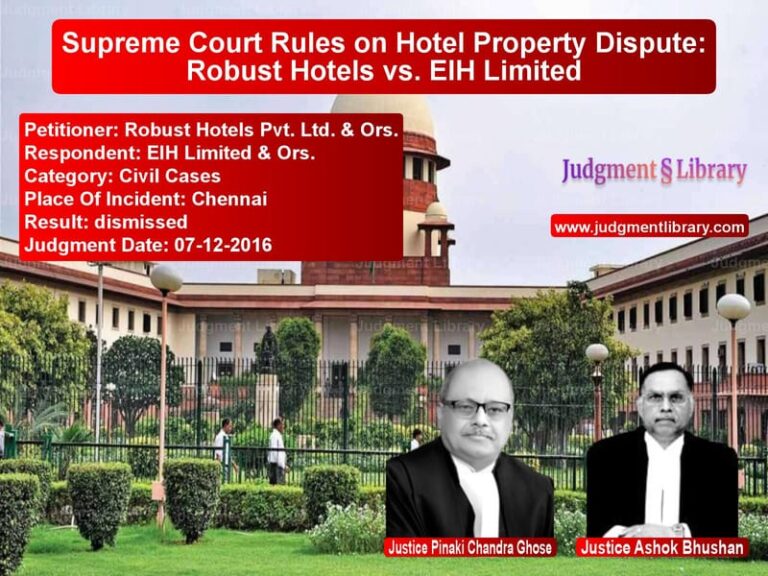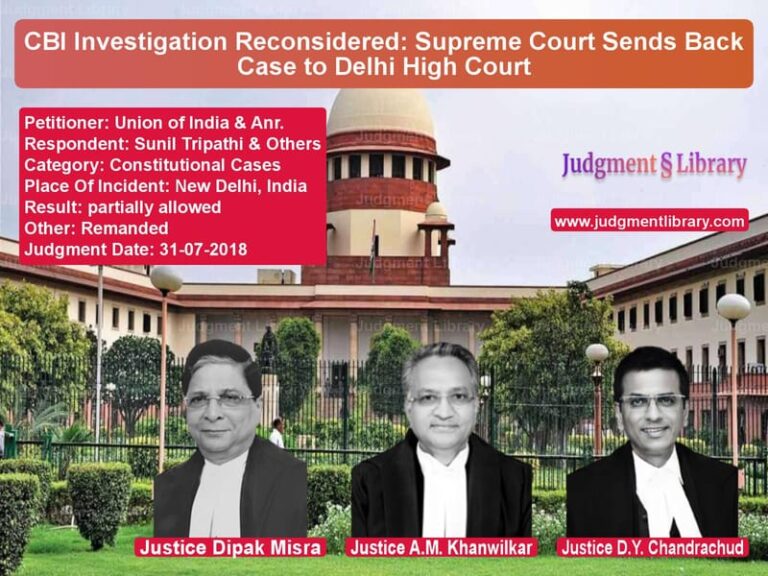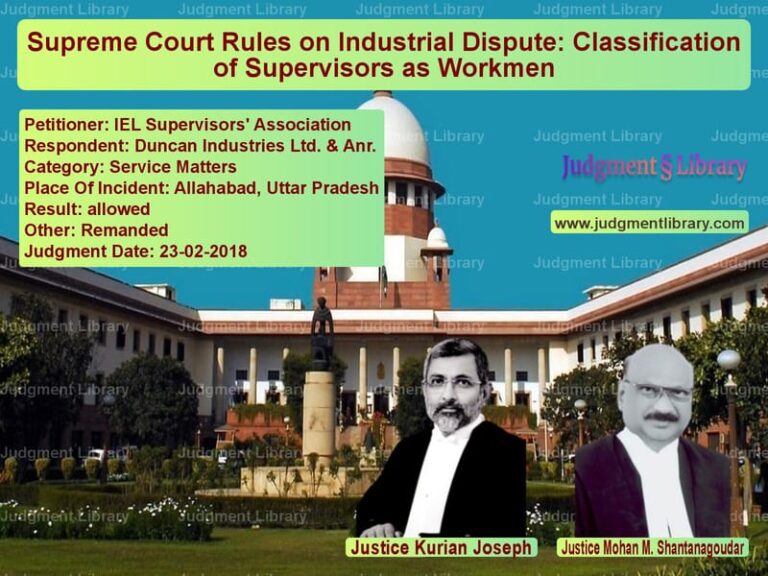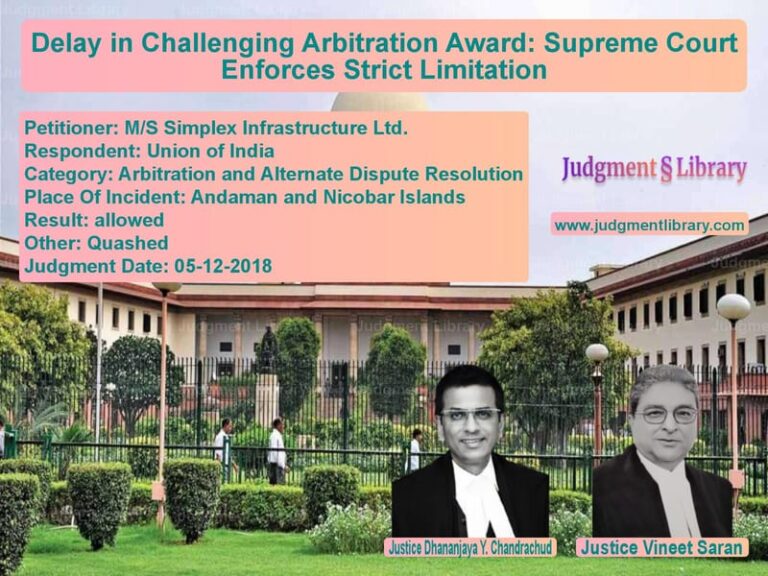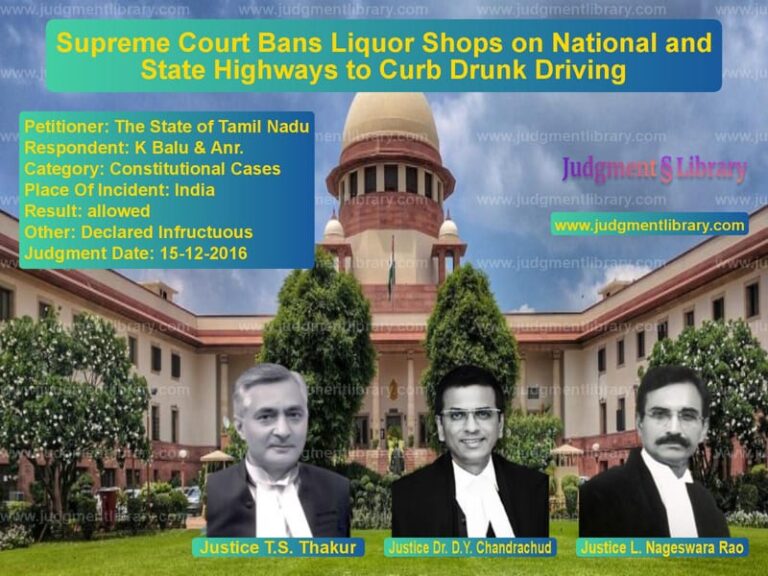Supreme Court Cancels Bail in POCSO Case: Landmark Ruling on Child Sexual Assault Bail Standards
In a powerful judgment that reinforces the seriousness of crimes against children, the Supreme Court of India has set aside the bail granted to a convict in a POCSO case, sending a strong message about the standards required for suspending sentences in child sexual assault cases. The case involving Jamnalal versus the State of Rajasthan represents a significant judicial intervention that prioritizes the protection of child victims over the liberty of convicted offenders. This landmark ruling clarifies the legal principles governing suspension of sentences and bail in cases under the Protection of Children from Sexual Offences Act, establishing crucial precedents for how courts should handle such sensitive matters.
The Horrific Crime and Trial Court Conviction
The case originated from a deeply disturbing incident that occurred on June 13, 2023, when a 14-year-old girl went to a field to defecate. According to the prosecution’s case, Respondent No. 2 approached her from behind, held her at gunpoint, covered her mouth, and forcibly took her to a nearby house where he committed rape. The victim immediately reported the incident to her family, who lodged a First Information Report at the police station. The medical examination confirmed that the victim was a minor, with her date of birth established as March 7, 2009, making her 14 years and 3 months old at the time of the incident.
The Trial Court, after examining all evidence, convicted Respondent No. 2 under Section 3/4(2) of the POCSO Act and sentenced him to 20 years of rigorous imprisonment along with a fine of Rs. 50,000. The court relied heavily on the consistent testimony of the victim, who maintained her account both in her court deposition and in her statement recorded under Section 164 of the Code of Criminal Procedure. The Trial Court also invoked the presumptions under Sections 29 and 30 of the POCSO Act, which create legal presumptions in favor of the prosecution in cases involving sexual offenses against children.
The High Court’s Controversial Bail Decision
After serving only 1 year and 3 months of his 20-year sentence, Respondent No. 2 approached the High Court seeking suspension of his sentence and release on bail during the pendency of his appeal. Surprisingly, the High Court granted his request, providing only brief reasoning for its decision. The High Court noted that “no sign of sexual assault was found by the medical expert on the body of the prosecutrix; no FSL as well as DNA report is available on record; despite the availability of washrooms in the house, it is little difficult to digest that prosecutrix will go out for toilet; there is no prospect of being heard and disposal of this appeal in near future.”
This decision by the High Court prompted the victim’s father, Jamnalal, to approach the Supreme Court, challenging what he perceived as a gross miscarriage of justice that prioritized technicalities over the substantive evidence and the gravity of the offense.
The Supreme Court’s Scrutiny of Legal Principles
The Supreme Court bench comprising Justices B.V. Nagarathna and K.V. Viswanathan delivered a comprehensive judgment that systematically dismantled the High Court’s reasoning and established clear legal standards for such cases. The Court began by examining the scope of Section 389 of the Code of Criminal Procedure, which governs suspension of sentence during appeals.
The Court referenced its earlier judgment in Omprakash Sahni v. Jai Shankar Chaudhary and Another, which had clearly explained the legal position: “The principle underlying the theory of criminal jurisprudence in our country is that an accused is presumed to be innocent till he is held guilty by a court of competent jurisdiction. Once the accused is held guilty, the presumption of innocence gets erased.” The Court further elaborated that “the endeavour on the part of the court, therefore, should be to see as to whether the case presented by the prosecution and accepted by the trial court can be said to be a case in which, ultimately the convict stands for fair chances of acquittal. If the answer to the abovesaid question is to be in the affirmative, as a necessary corollary, we shall have to say that, if ultimately the convict appears to be entitled to have an acquittal at the hands of this Court, he should not be kept behind the bars for a pretty long time till the conclusion of the appeal.”
However, the Supreme Court cautioned that “while undertaking the exercise to ascertain whether the convict has fair chances of acquittal, what is to be looked into is something palpable. To put it in other words, something which is very apparent or gross on the face of the record, on the basis of which, the court can arrive at a prima facie satisfaction that the conviction may not be sustainable. The appellate court should not reappreciate the evidence at the stage of Section 389 CrPC and try to pick up a few lacunae or loopholes here or there in the case of the prosecution. Such would not be a correct approach.”
Disturbing Criminal Antecedents Revealed
A significant factor that weighed heavily with the Supreme Court was the criminal history of Respondent No. 2. The State of Rajasthan submitted an affidavit detailing his criminal antecedents, which revealed a pattern of involvement with the law. The chart presented to the Court showed that Respondent No. 2 had been involved in 11 criminal cases, with 5 resulting in acquittals and 6 still pending trial. These cases included offenses under the Arms Act, sections related to hurt, wrongful restraint, house trespass, theft, and even more serious charges under Section 394 IPC (robbery).
This history demonstrated that Respondent No. 2 was not a first-time offender but someone with repeated encounters with the criminal justice system, a factor the Supreme Court found crucial in assessing his suitability for bail.
The Flawed Reasoning of the High Court
The Supreme Court systematically analyzed and rejected each of the grounds cited by the High Court for granting bail. Regarding the medical evidence, the Court noted that “the finding that no sexual assault was found, without considering the overall nature of the evidence of the case, is completely untenable. According to the evidence of the prosecutrix, Respondent No.2, at gunpoint, closed her mouth and forcibly took her to the house of Amro and committed rape on her. All that the medical evidence said was that no conclusive opinion about the crime could be given since FSL Report was awaited. That does not mean that the ocular evidence could be ignored.”
Read also: https://judgmentlibrary.com/supreme-court-reinstates-murder-conviction-in-bihar-fire-tragedy-case/
The Court particularly criticized the High Court’s reasoning about the victim going to the field instead of using washrooms at home, calling it “conjectural in nature.” The Supreme Court emphasized that such speculative reasoning had no place in the evaluation of evidence, especially in cases involving sexual offenses against children.
Interestingly, the State revealed in its counter-affidavit that the FSL report, which had been received after the trial concluded, actually contained incriminating evidence showing “the presence of male DNA/semen of the accused on the private part and underwear of the victim.” While the Supreme Court refrained from commenting on the merits of this report, it noted that this development further undermined the High Court’s reasoning.
Legal Distinction: Setting Aside vs Cancelling Bail
The Supreme Court also addressed an important legal distinction raised by Respondent No. 2’s counsel, who argued that there was no allegation of post-bail misconduct warranting cancellation of bail. The Court clarified that “There is clear distinction in law between setting aside of the bail by a higher Court and cancellation of the bail. While cancellation of bail is due to some supervening circumstances like breach of bail condition, setting aside of the bail is concerned not with the breach of condition but with the justifiability and soundness of the order granting bail.”
This distinction was crucial because it allowed the Supreme Court to examine whether the High Court’s order was legally sound at the time it was passed, rather than requiring evidence of subsequent misconduct.
Application to POCSO Cases
The Supreme Court referenced its judgment in Vijay Kumar v. Narendra and Others, which had laid down principles for granting bail in serious offenses like murder. The Court observed that “though said in the context of Section 302 IPC, it applies with equal force to a case of the present nature under the POCSO Act.” The principles require courts to consider “the nature of the accusation made against the accused, the manner in which the crime is alleged to have been committed, the gravity of the offence, and the desirability of releasing the accused on bail after they have been convicted for committing the serious offence.”
The Supreme Court found that the High Court had failed to consider these relevant factors while granting bail to a convict in a case involving sexual assault of a minor.
The Final Verdict and Its Implications
After thorough analysis, the Supreme Court concluded that “the reasoning of the High Court, set out above, falls far short of the parameters required under Section 389 of Cr.P.C. for enlargement of a convict, punished for heinous offence, on bail after suspending the sentence.” The Court set aside the High Court’s order and directed Respondent No. 2 to surrender before the Special Judge (POCSO) Karauli on or before August 30, 2025, failing which the State was authorized to take him into custody.
This judgment serves as a significant precedent that reinforces the seriousness with which courts must approach cases under the POCSO Act. It establishes that suspension of sentence and bail in such cases cannot be granted based on technicalities or speculative reasoning, especially when the Trial Court has convicted the accused after thorough examination of evidence. The ruling emphasizes that the presumption of innocence disappears after conviction, and courts must exercise extreme caution before releasing convicts of heinous crimes against children during the pendency of their appeals.
The judgment also sends a strong message about the importance of considering the criminal antecedents of the accused and the overall gravity of the offense, rather than focusing narrowly on individual pieces of evidence. By setting aside the bail in this case, the Supreme Court has reaffirmed its commitment to protecting the most vulnerable members of society and ensuring that justice is not diluted through procedural technicalities.
Petitioner Name: Jamnalal.Respondent Name: State of Rajasthan & Another.Judgment By: Justice B.V. Nagarathna, Justice K. V. Viswanathan.Place Of Incident: Karauli, Rajasthan.Judgment Date: 06-08-2025.Result: allowed.
Don’t miss out on the full details! Download the complete judgment in PDF format below and gain valuable insights instantly!
Download Judgment: jamnalal-vs-state-of-rajasthan-&-supreme-court-of-india-judgment-dated-06-08-2025.pdf
Directly Download Judgment: Directly download this Judgment
See all petitions in Rape Cases
See all petitions in Bail and Anticipatory Bail
See all petitions in Juvenile Justice
See all petitions in Judgment by B.V. Nagarathna
See all petitions in Judgment by K.V. Viswanathan
See all petitions in allowed
See all petitions in Quashed
See all petitions in supreme court of India judgments August 2025
See all petitions in 2025 judgments
See all posts in Criminal Cases Category
See all allowed petitions in Criminal Cases Category
See all Dismissed petitions in Criminal Cases Category
See all partially allowed petitions in Criminal Cases Category

